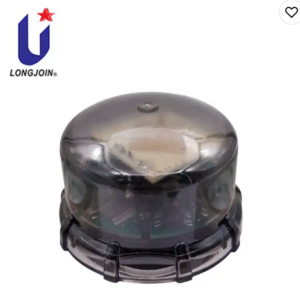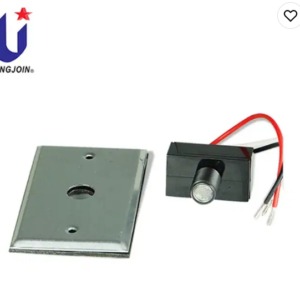JL-250F NEMA (7P)-Surge Protection
Product Details:



Summary
The JL-250F is designed for outdoor lamps and installed between the traditional NEMA socket and the light controller. It is used for rapid transformation to improve the surge protection capability of the NEMA interface lamps. The SPD inside the lamps can be replaced by JL-250F, which is more convenient for installation、maintenance and replacement, and can effectively reduce operation and maintenance costs. The product has built-in surge differential mode + surge common mode protection, which greatly improves the working ability of the light controller in the complex electromagnetic interference environment. The combination design of temperature fuse and MOV+GDT can avoid the deterioration of heating caused by aging and over-energy of MOV. The center of the bottom is equipped with a ground hole design, which can provide the grounding circuit of the lamp controller and improve the common mode suppression ability of the lamp.
Features
- Product certification:ANSI C136.41、UL 1449、UL 773、ROHS、CB、CE、UKCA
- Component certification:UL、CUL、TUV、VDE、PSE、CQC、ROHS、REACH
- 20KV/10KA,10KV/5KA Different protection levels are available
- Differential mode + common mode protection(L-N,L-G,N-G)
- 1.2/50us & 8/20us combined wave performance tests
- Center ground hole design
- Diagnostic LED
- GDT+MOV, prevent MOV aging to form leakage current, longer life
- Built-in temperature fuse, over-temperature protection
- High strength PC material
- Gold-plated signal terminals in phosphor bronze nickel plating, gold-plated in
- accordance with ASTM B 522
- Copper plug
- Flat design, less wind resistance
- Human mechanical handshake design, more convenient rotation
Installation
- Connect the bottom socket cable
- Insert 250F and turn clockwise to tighten
- Insert the light controller and turn clockwise to tighten
Note: If the lamp controller has the need of common mode surge protection, the bottom cable socket needs
to use our JL-250G model, its center position has a grounding column design, can be matched with
If you want more details information about JL-250F, welcome to contact us : info@chiswear.com
relevant knowledge:
1.What is a Surge Protector? Professional Explanation and Uses
A surge protector, also known as a surge suppressor or lightning arrester, is an electronic device designed to protect electrical equipment from voltage spikes. Surge protectors work by limiting the voltage supplied to an electronic device either by blocking or by shorting to ground any unwanted voltages above a safe threshold. Surges can occur for a variety of reasons, including lightning strikes, power outages, or malfunctions in the power grid.
Surge protectors are crucial for safeguarding sensitive electronics and communication lines from sudden increases in voltage which can cause irreparable damage. Common applications include protecting computers, telecommunication equipment, and other home and office appliances. They are especially important in areas prone to electrical storms or unstable electrical grids.
By employing surge protectors, individuals and businesses can prevent costly damage and data loss, ensuring that their systems operate reliably without interruption due to electrical disturbances.

2.What is the protection mode of a surge protector? What is the difference between common mode and full mode protection of a surge protector?
Surge protectors, also known as SPDs (Surge Protection Devices), use different protection modes to safeguard electrical equipment from voltage spikes. These modes are typically categorized as common mode and differential mode (also known as mode protection).
Common Mode Protection
Common mode protection addresses voltage surges between the live wires (or hot lines) and the ground. This mode is crucial for protecting against surges that might occur due to external sources like lightning strikes. The protection works by diverting the excess voltage from the live wires directly to the ground, thereby protecting the connected devices.
Differential Mode Protection
Differential mode protection, on the other hand, deals with surges between the live wires themselves, such as between a phase and neutral wire. This type of protection is vital for handling surges that occur from within the building’s electrical system, such as those caused by switching heavy appliances on and off. It limits the voltage difference seen by the electrical device to a safe threshold.
The key difference between these modes is their path of surge diversion—common mode diverts to ground, while differential mode manages the difference directly across the supply.
For comprehensive safety, many surge protectors combine both protection modes to cover a wide range of potential electrical disturbances. This dual approach ensures robust protection against various types of electrical surges, from both internal and external sources.
3.Why we use thermal cutoffs and MOV+GDT combination designs, e.g. for lightning protection of luminaires?
When designing for lightning protection in lighting fixtures, a combination of a thermal fuse, MOV (Metal Oxide Varistor), and GDT (Gas Discharge Tube) can provide comprehensive protection. Here’s an explanation of how this combination works to protect the lighting fixture from lightning strikes:
-
Thermal Fuse:
- Function: A thermal fuse is an overheat protection device that prevents overheating in electrical circuits. It disconnects the circuit when the temperature exceeds a preset safety threshold, thus preventing fires or other hazards caused by excessive heat.
- Role in Lightning Protection: While a thermal fuse does not directly participate in lightning protection, it ensures that if heat generated by MOV and GDT during lightning protection reaches a dangerous level, the circuit will be safely disconnected to prevent damage to the lighting fixture due to overheating.
-
MOV (Metal Oxide Varistor):
- Function: MOV is a nonlinear resistance device that exhibits a sharp decrease in resistance with increasing voltage. When an overvoltage occurs in the circuit, MOV quickly conducts and absorbs the overvoltage, converting it into heat, thus protecting the lighting fixture from overvoltage damage.
- Role in Lightning Protection: MOV is a key component in the lightning protection circuit. It responds quickly and limits the amplitude of the overvoltage, preventing it from damaging the lighting fixture.
-
GDT (Gas Discharge Tube):
- Function: GDT is a switching-type overvoltage protection device filled with inert gas. When the voltage in the circuit exceeds the GDT’s discharge voltage, it quickly discharges, diverting the overvoltage to the ground, thus protecting the lighting fixture from damage.
- Role in Lightning Protection: GDT works synergistically with MOV to provide dual protection for the lighting fixture. GDT has high surge current capability and fast response characteristics, enabling it to quickly discharge and divert overvoltage to the ground during lightning or strong electromagnetic pulses, thus protecting the lighting fixture from damage.
How the Combination Works:
- When the lighting fixture is subjected to a lightning strike or other forms of overvoltage, GDT responds first, diverting the overvoltage to the ground. This quickly reduces the amplitude of the overvoltage, reducing its impact on the lighting fixture.
- At the same time, MOV also starts to operate, absorbing the remaining overvoltage and converting it into heat. This further reduces the effect of overvoltage on the lighting fixture.
- If the heat generated during lightning protection exceeds the safety threshold, the thermal fuse will disconnect the circuit, ensuring the safety of the lighting fixture.
This combination design leverages the unique characteristics of the thermal fuse, MOV, and GDT to provide comprehensive and effective lightning protection for lighting fixtures.

Common Mode Protection
Differential Mode Protection
Surges between the live wire and the ground wire are common malfunction issues for traffic systems. These surges can be caused by lightning strikes hitting nearby transformers or faults within the power grid. Differential mode protection is essential for preventing damage to the internal circuitry of traffic control equipment.
This way because of the wiring, there are requirements for operators, and the efficiency is also lower, especially when the old project renovation (want to add SPD) and maintenance replacement.






